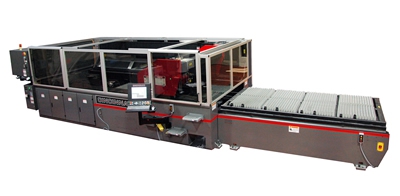
The new CL-400 CO2 laser cutting system combines Cincinnati Incorporated's most popular, performance-driving features from its CL-800 and CL-900 models in an affordable package for shops looking to add laser-cutting capability. Priced under $500K, the CL-400 uses the water-cooled, high-speed linear motor drives pioneered by Cincinnati, and the same powerful HMI touch screen control and nesting software found on the company's other CO2 and fiber laser cutting systems. Dual 5 x 10 ft. (1.5 x 3 m) pallets and an optional modular material handling system (MMHS) reduce beam-off time and further boost productivity. Designed for high throughput and all-around material versatility, the CL-400 delivers fast positioning speeds of 12,000 ipm and up to 1" processing range on mild steel. The laser cutting system features a low-maintenance 4000-watt resonator, providing all-around material versatility and cutting precision.
"We've selected a highly reliable, clean running CO2 resonator for the new system," said Todd Kirchoff, product manager for Cincinnati. "We've also made significant investments in our operations to improve our flow and productivity. As a result, we're able to offer the CL-400 at a lower price point, while loading it up with features found on our more advanced systems. This gives customers another choice in determining the right laser cutting system to fit their performance needs and budgets."
The CL-400's fourth-generation linear motor drives make fast work of large parts or batch processing of smaller parts, while delivering industry-best dynamic positioning accuracy of +/-0.001" at high cutting speeds. The machine"s heavy .75" to 1.5" steel plate frame provides durability, stability and enhanced accuracy, according to the company. The steel plate is cut, formed, welded, stress relieved and precision machined to make an extremely rigid base for all the laser's components. The separate load frame is made of 1.5" plate steel to withstand repetitive loading and unloading without affecting the cutting process.
The resonator features a low-speed, oil-free turbine designed specifically for laser use and a gas filtration module that continuously purifies the gases flowing through the resonator. The effectiveness of the filtration allows the laser to produce excellent power stability while using simple, industrial grade, non-specialized laser gases. These features provide a clean, low-maintenance laser that reduces costs and meets the demands of a three-shift operation.
The intuitive, Windows-based HMI control enables operators to produce good parts independently and is compatible with all other Cincinnati laser systems. The company's Laser Programming and Nesting software increases productivity and optimizes material usage by selecting the best size sheet for a parts nest, particularly useful for systems with automated material handling. The software automatically performs sequencing, process optimization and feature avoidance, allowing the machine to run head-down without risk of crashing into tipped up slugs. It adjusts part programs and codes to the machine's speed, acceleration/deceleration and processing capabilities, avoiding the need to write or modify part programs and enabling optimum efficiency.
The optionalmmHS ups the ante on productivity and its modular design allows configuration of everything from a simple load/unload system to a full system with material storage serving multiple lasers.
Contact Details
Related Glossary Terms
- inches per minute ( ipm)
inches per minute ( ipm)
Value that refers to how far the workpiece or cutter advances linearly in 1 minute, defined as: ipm = ipt 5 number of effective teeth 5 rpm. Also known as the table feed or machine feed.
- linear motor
linear motor
Functionally the same as a rotary motor in a machine tool, a linear motor can be thought of as a standard permanent-magnet, rotary-style motor slit axially to the center and then peeled back and laid flat. The major advantage of using a linear motor to drive the axis motion is that it eliminates the inefficiency and mechanical variance caused by the ballscrew assembly system used in most CNC machines.
- modular design ( modular construction)
modular design ( modular construction)
Manufacturing of a product in subassemblies that permits fast and simple replacement of defective assemblies and tailoring of the product for different purposes. See interchangeable parts.






